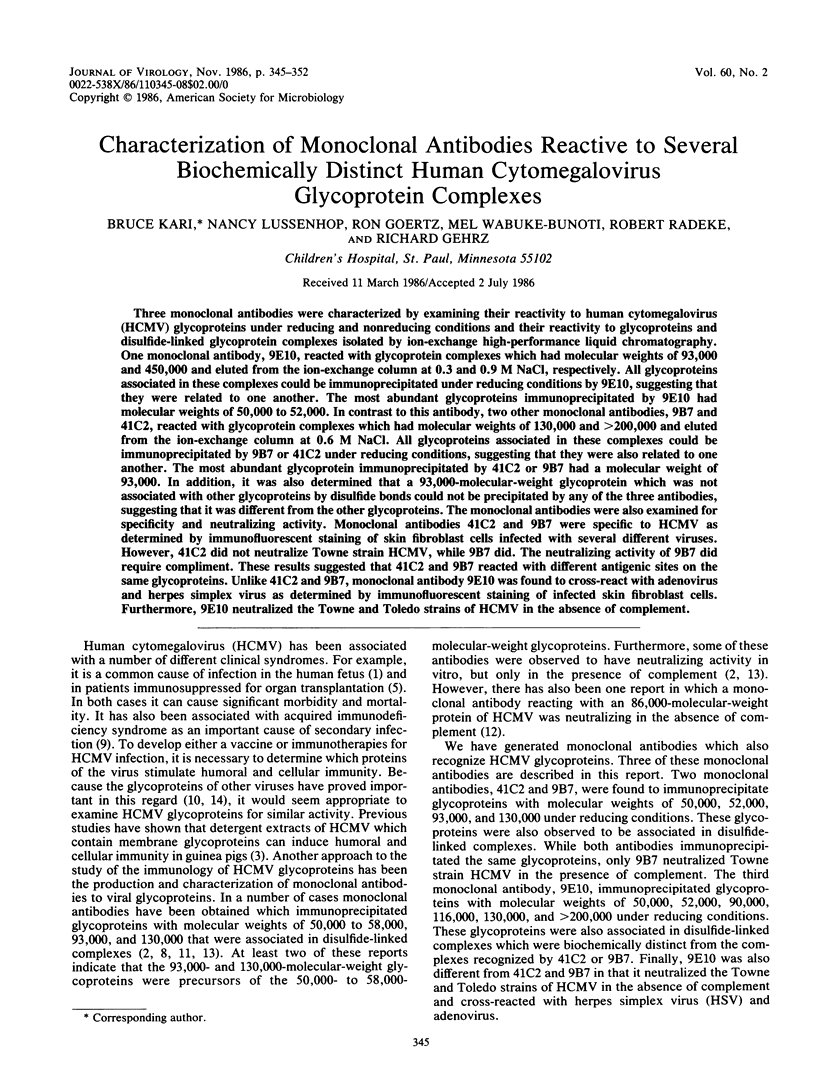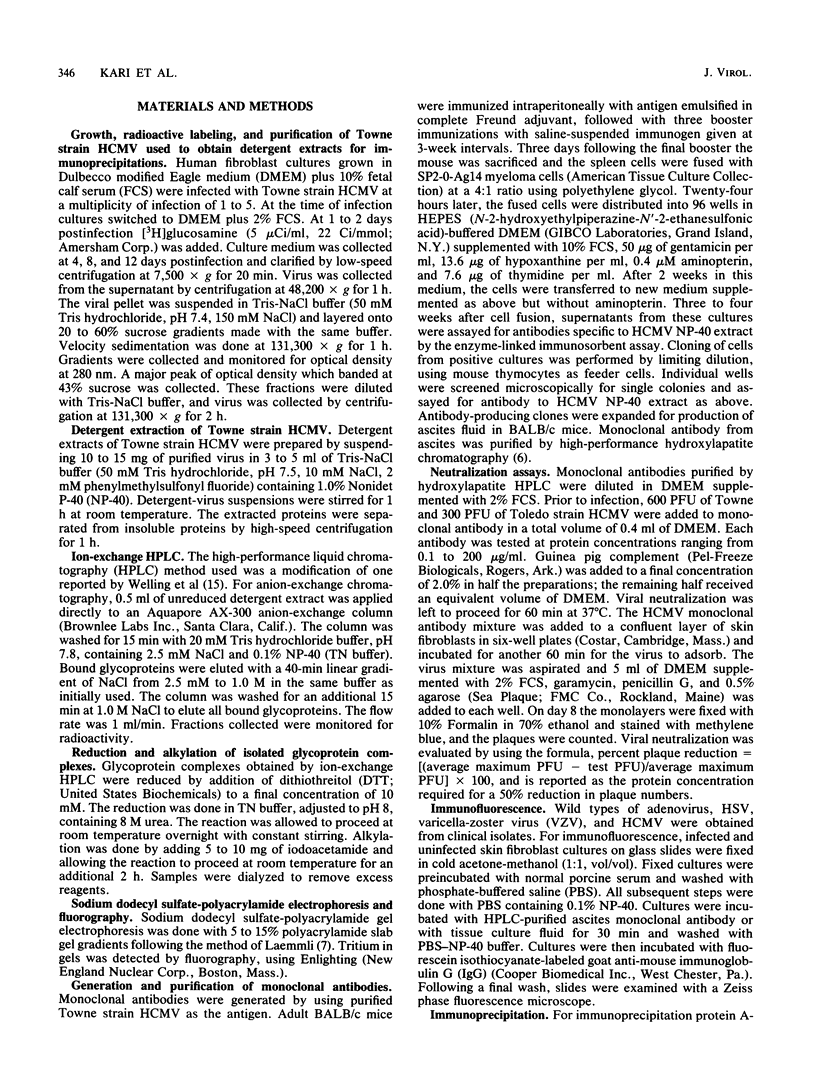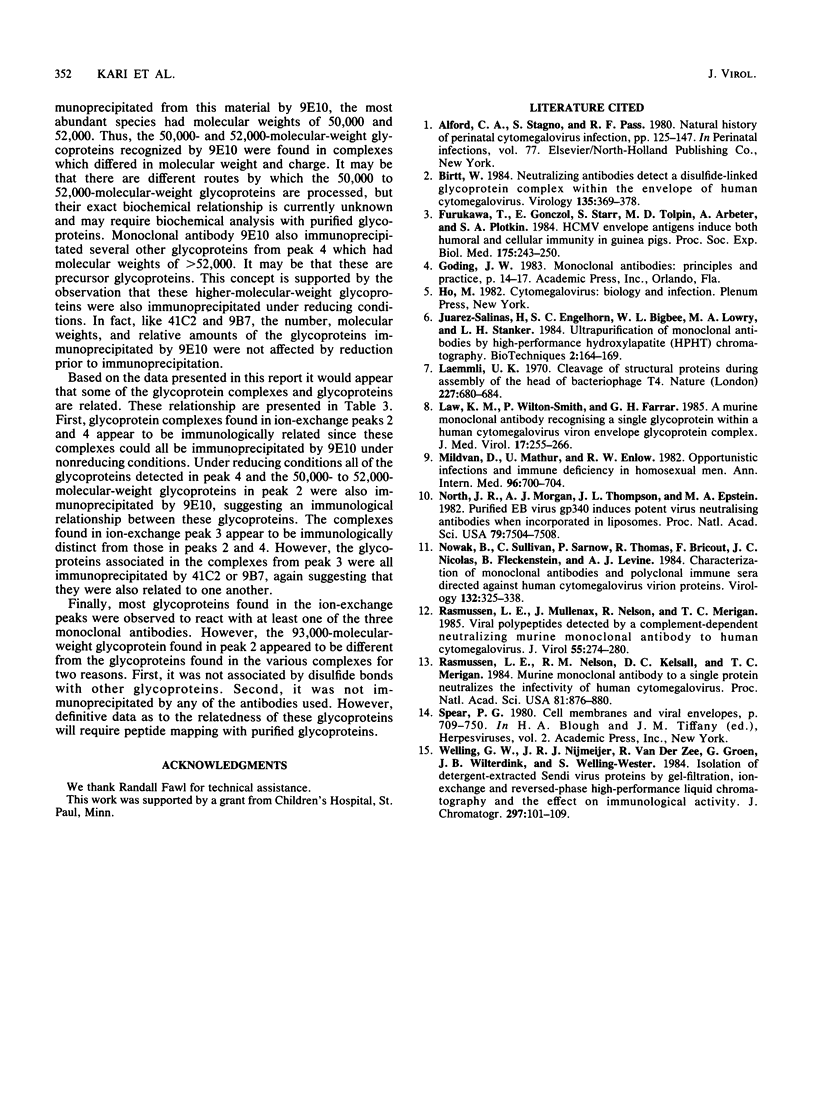Abstract
Three monoclonal antibodies were characterized by examining their reactivity to human cytomegalovirus (HCMV) glycoproteins under reducing and nonreducing conditions and their reactivity to glycoproteins and disulfide-linked glycoprotein complexes isolated by ion-exchange high-performance liquid chromatography. One monoclonal antibody, 9E10, reacted with glycoprotein complexes which had molecular weights of 93,000 and 450,000 and eluted from the ion-exchange column at 0.3 and 0.9 M NaCl, respectively. All glycoproteins associated in these complexes could be immunoprecipitated under reducing conditions by 9E10, suggesting that they were related to one another. The most abundant glycoproteins immunoprecipitated by 9E10 had molecular weights of 50,000 to 52,000. In contrast to this antibody, two other monoclonal antibodies, 9B7 and 41C2, reacted with glycoprotein complexes which had molecular weights of 130,000 and greater than 200,000 and eluted from the ion-exchange column at 0.6 M NaCl. All glycoproteins associated in these complexes could be immunoprecipitated by 9B7 or 41C2 under reducing conditions, suggesting that they were also related to one another. The most abundant glycoprotein immunoprecipitated by 41C2 or 9B7 had a molecular weight of 93,000. In addition, it was also determined that a 93,000-molecular-weight glycoprotein which was not associated with other glycoproteins by disulfide bonds could not be precipitated by any of the three antibodies, suggesting that it was different from the other glycoproteins. The monoclonal antibodies were also examined for specificity and neutralizing activity. Monoclonal antibodies 41C2 and 9B7 were specific to HCMV as determined by immunofluorescent staining of skin fibroblast cells infected with several different viruses. However, 41C2 did not neutralize Towne strain HCMV, while 9B7 did. The neutralizing activity of 9B7 did require complement. These results suggested that 41C2 and 9B7 reacted with different antigenic sites on the same glycoproteins. Unlike 41C2 and 9B7, monoclonal antibody 9E10 was found to cross-react with adenovirus and herpes simplex virus as determined by immunofluorescent staining of infected skin fibroblast cells. Furthermore, 9E10 neutralized the Towne and Toledo strains of HCMV in the absence of complement.
Full text
PDF







Images in this article
Selected References
These references are in PubMed. This may not be the complete list of references from this article.
- Britt W. J. Neutralizing antibodies detect a disulfide-linked glycoprotein complex within the envelope of human cytomegalovirus. Virology. 1984 Jun;135(2):369–378. doi: 10.1016/0042-6822(84)90193-4. [DOI] [PubMed] [Google Scholar]
- Furukawa T., Gonczol E., Starr S., Tolpin M. D., Arbeter A., Plotkin S. A. HCMV envelope antigens induce both humoral and cellular immunity in guinea pigs. Proc Soc Exp Biol Med. 1984 Feb;175(2):243–250. doi: 10.3181/00379727-175-41796. [DOI] [PubMed] [Google Scholar]
- Laemmli U. K. Cleavage of structural proteins during the assembly of the head of bacteriophage T4. Nature. 1970 Aug 15;227(5259):680–685. doi: 10.1038/227680a0. [DOI] [PubMed] [Google Scholar]
- Law K. M., Wilton-Smith P., Farrar G. H. A murine monoclonal antibody recognising a single glycoprotein within a human cytomegalovirus virion envelope glycoprotein complex. J Med Virol. 1985 Nov;17(3):255–266. doi: 10.1002/jmv.1890170307. [DOI] [PubMed] [Google Scholar]
- Mildvan D., Mathur U., Enlow R. W., Romain P. L., Winchester R. J., Colp C., Singman H., Adelsberg B. R., Spigland I. Opportunistic infections and immune deficiency in homosexual men. Ann Intern Med. 1982 Jun;96(6 Pt 1):700–704. doi: 10.7326/0003-4819-96-6-700. [DOI] [PubMed] [Google Scholar]
- North J. R., Morgan A. J., Thompson J. L., Epstein M. A. Purified Epstein-Barr virus Mr 340,000 glycoprotein induces potent virus-neutralizing antibodies when incorporated in liposomes. Proc Natl Acad Sci U S A. 1982 Dec;79(23):7504–7508. doi: 10.1073/pnas.79.23.7504. [DOI] [PMC free article] [PubMed] [Google Scholar]
- Nowak B., Sullivan C., Sarnow P., Thomas R., Bricout F., Nicolas J. C., Fleckenstein B., Levine A. J. Characterization of monoclonal antibodies and polyclonal immune sera directed against human cytomegalovirus virion proteins. Virology. 1984 Jan 30;132(2):325–338. doi: 10.1016/0042-6822(84)90039-4. [DOI] [PubMed] [Google Scholar]
- Rasmussen L. E., Nelson R. M., Kelsall D. C., Merigan T. C. Murine monoclonal antibody to a single protein neutralizes the infectivity of human cytomegalovirus. Proc Natl Acad Sci U S A. 1984 Feb;81(3):876–880. doi: 10.1073/pnas.81.3.876. [DOI] [PMC free article] [PubMed] [Google Scholar]
- Rasmussen L., Mullenax J., Nelson R., Merigan T. C. Viral polypeptides detected by a complement-dependent neutralizing murine monoclonal antibody to human cytomegalovirus. J Virol. 1985 Aug;55(2):274–280. doi: 10.1128/jvi.55.2.274-280.1985. [DOI] [PMC free article] [PubMed] [Google Scholar]
- Welling G. W., Nijmeijer J. R., van der Zee R., Groen G., Wilterdink J. B., Welling-Wester S. Isolation of detergent-extracted Sendai virus proteins by gel-filtration, ion-exchange and reversed-phase high-performance liquid chromatography and the effect on immunological activity. J Chromatogr. 1984 Aug 3;297:101–109. doi: 10.1016/s0021-9673(01)89033-6. [DOI] [PubMed] [Google Scholar]





